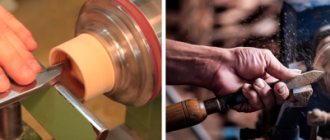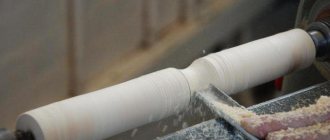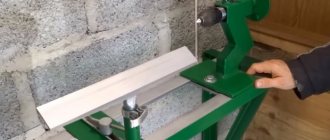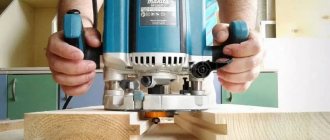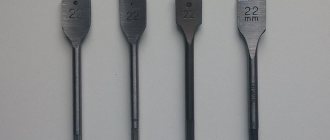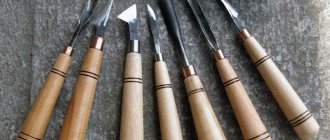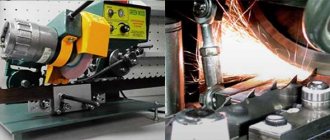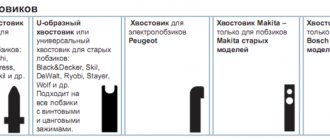Round and cylindrical wood products are used everywhere. Legs from chairs and beds, door handles and tool handles - all these pleasant to the touch and comfortable products are turned on lathes.
Unlike the processing of metal products, where a part, clamped between the headstocks, is turned with a cutter mounted on a special mechanism, the movement of which is controlled by a turner, wood lathes only rotate the workpiece. Grinding is carried out by a person using a special hand tool - turning cutters. With the help of different shapes and configurations of these tools, craftsmen achieve excellent results when working on a lathe.
Description of turning tools
The wood cutter is made of high strength steel.
Although wood is a soft material, the cutting part is subjected to significant loads, and even heats up from constant friction. Therefore, factory cutters are made from alloy and carbon steels, which hold an edge for a long time and at the same time are not too fragile, that is, they do not crumble as a result of a sharp increase in load (for example, when they hit an internal knot in hard wood).
Each cutter consists of the following parts:
- blade – comes into contact with the workpiece and, due to its sharpness, removes a layer of wood;
- working part (body) - one end of it is sharpened to a blade, and the other ends with a shank, the turner holds it with his hand;
- shank - the narrowed end of the working part, onto which a wooden handle is mounted.
The handle is usually made of wood and consists, in turn, of a thick cylindrical base and a narrow neck, on which a metal ring is usually put on, which protects it from cracking when placed on the shank.
Varieties
All devices used for the manufacture, finishing and decoration of turning workpieces can be divided into several general types:
. The shape resembles a knife, but unlike a regular knife, a turning knife uses only the tip. Parting tools are worked by turning their plane vertically, unlike chisels, which are held horizontally. Using a turning knife, a part of the workpiece is cut off and deep grooves are made.
Cut-off- Chisels . Flat or semicircular objects with a sharpened blade. They select a part of the material, pressing it against the workpiece parallel to the floor or at a slight angle. Thanks to chisels, a beam or log, sandwiched between the headstocks, takes the shape of a curly bed leg or an evenly tapering baseball bat.
- Scrapers . They are used after the product has been given a rough shape. Unlike a chisel, a scraper does not have a sharpened blade - the cut is made using the hard edge of the end. Thanks to scrapers, both decorative and functional complex ring cuts can be made in wood. The most common scrapers are shaped like the letter R.
Various options and their purpose
The variety of cutting tools for wood when rotating on a lathe is very large. Experienced craftsmen create cutters of the shape they consider convenient for the implementation of individual tasks. Therefore, one personal cutter is not similar to another. However, there are standards for factory tools, some of which are basic, others highly specialized.
Reyer
This is one of the basic incisors. It can be recognized by its characteristic shape - the working part of the rail is not flat, but curved, forming a groove. Sharpening is done from the inside of the curve. They work with a rake, bringing it to the workpiece with the groove up.
Thanks to the shape of the blade, this cutter selects wood in a semicircle. Its longitudinally curved shape makes it very durable, making it well suited for rough turning of workpieces. With the help of a reyer you can also make smooth transitions and grooves with a semicircular profile.
The width of the rib ranges from 4 to 30 mm, and the sharpening angle is about 30 degrees.
Meysel
If a reyer is a relatively simple tool, which is intended primarily for rough, rough work, then a meisel is already much more difficult to use.
It is unlikely that you will be able to master it in a couple of days of practice. This cutter is used already when the outlines of the wooden product are formed.
However, for an experienced turner, the use of a meisel gives an even, smooth surface of wood of a given geometry.
The Meisel is a bit like a regular flat hammer chisel, but its blade is angled. Accordingly, the master must have at his disposal at least two meisels - left- and right-handed - in order to process mirrored areas.
Sharpening the meisel can be done either by beveling one side until it comes out flat, or by equally removing the metal layer from both sides. In this case, the width of the blade can reach up to 40 mm, and the bevel angle ranges from 60 to 75 degrees. When sharpening a cutting edge on both sides, the angle should be 20 – 25° on each side.
Shaped
After the main processing of the part in the headstocks has been completed, it is the turn of the figured cut. For this purpose, shaped cutters are used. They can have different shapes for turning grooves, grooves, and select grooves of complex shapes.
Klukarza.
The most common “styles” are:
- Klukarza . The shape of the cutter is similar to the reyer, but has a bend in the working part near the blade. Thanks to this shape, the cranberry can be used for small and complex work; it can reach places where tools with a straight working part cannot reach.
- Comb . It makes parallel grooves and grooves. With the proper level of skill, a thread is cut using a comb.
- Hook . Allows you to make an internal recess with a protruding edge, as well as various curved grooves.
- Crescent or dovetail . Used for turning round and faceted beads.
The process of turning a workpiece on a lathe significantly depends on the sharpening angle of the tool. Small angles (20 – 30°) are intended for fine work.
They remove wood well, but if moved carelessly they can damage the workpiece or break themselves. Large angles (60 – 75°) are intended for rough work with hard rocks.
They can remove less in one pass, but they are not afraid of knots and pressure created by the turner.
About creating with your own hands
Experienced turners make their own cutters for work, not being satisfied with the assortment that is on sale. Plus, it's significantly cheaper. The material used is old tools that have served their purpose: files, needle files, rasps and other flat objects with sufficient hardness.
In order to make a cutting edge, sharpening machines with diamond wheels are used. The easiest way is to make a straight blade - to do this, just sharpen the end of the tool.
When removing metal on a wheel at high speed, you must avoid overheating the steel. Otherwise, the metal will be tempered, and the future cutter will quickly lose its sharpness. Supplying water to the wheel while sharpening is one of the best cooling options. However, if you overheat the cutter during the process, it doesn’t matter. It can be hardened again by heating it red-hot with a propane torch and then running in water or oil.
What wood lathe cutters do you use?
Blades with complex configurations will have to be adjusted manually using thin files and diamond needle files. If the farm has an engraver, it can also be used with conical, cylindrical and spherical burrs (cutters). This way you can get a cutter of any configuration.
After the body is ready, they begin to handle the handle. On turning tools, the shank is increased to accommodate a longer handle for convenience. It is advisable to burn the drilled hole in the handle by heating the shank and inserting it “hot” so that the wood will crack less.
Best sets
DEXX 1834-H11_z01
- type : chisel;
- profile : flat, oblique, curved;
- handle material : wood;
- blade material : alloy steel.
One of the most affordable sets. There are 11 chisel-type cutters, there are both semicircular and oblique blades. Suitable for most small carpentry work.
Factory sharpening is only indicated, so upon purchase you will need to bring the tool into working condition.
STAYER 1831-H33
- type : cutter;
- profile : V-shaped, semicircular, flat, oblique, curved, square;
- reinforced handle;
- handle material : rubber, plastic;
- blade material : hardened steel.
Set with an impressive set of cutters. Some of them almost duplicate each other, so in case of breakdown there will be no problems. The cutters are put on the handle. There are two types: for rough shaping of the workpiece and for fine work.
DIY making
When making these tools, you cannot do without an electric sharpening machine (electric sharpener) with a set of abrasive wheels of different grain sizes. In most operations, it can be successfully replaced by a grinder with cutting and grinding discs.
Wood cutter blade
To make a tool blade, any used high-quality steel products are suitable - springs, drills, scalpels, rasps and even bearing rings.
For knives, the easiest choice is a hacksaw blade. Manufacturing consists of cutting it into pieces of the required length, forming the desired blade shape and sharpening.
The best option for chisels is a circular saw blade, the thickness of which is very suitable for this purpose. The carbon steel from which it is made holds an edge for a long time, even when processing hard wood. Cutting strips of the required size and grinding them to obtain the required blade shape is done using a grinder or an abrasive disc of an electric sharpener.
An old punch is perfect for a semicircular chisel - it already has the desired shape. It is enough just to cut off the excess metal from it and sharpen it.
During intensive grinding, the metal heats up, which causes a tempering, making it softer and unable to maintain an edge for a long time. Therefore, after giving the blade the desired shape and sharpening, hardening is required. To do this, you need to heat the cutting part using a gas or kerosene burner until it turns crimson and lower it into a container with machine oil.
Lever
Oak is considered the most suitable wood for the handle. Well, where it does not grow, it can be quite successfully replaced by birch, which, being burnt black with a gas burner and sanded, does not require any coating and is very comfortable to work with.
For wood knives, the handle can be made in the following way:
- cut two bars about 12 centimeters long and 12x22 millimeters in cross-section;
- attaching the shank of the blade to the block, circle it with a pencil;
- Use a chisel to select wood to the depth of the blade thickness;
- apply wood glue (PVA or EDF can be used) on the surface of the bars, connect the structure and tighten it with clamps or clamp it in a vice;
- After the glue has dried, plan the handle or grind it on an electric grinder and sand it.
For chisels, the handle can be turned on a lathe or cut from a whole block. Then drill a hole to the size of the shank and, having first put a crimp ring on the handle, which protects the wood from splitting, carefully place it on the blade.
Sharpening wood cutters
The final stage in the manufacture of wood cutters is the formation of the cutting part and sharpening. The main part of the metal from the cutting edge can be removed on the abrasive wheel of an electric sharpener or with the sharpening disc of an angle grinder.
The sharpening angles of the chamfers of all types of cutters are approximately the same and lie in the range of 18-25°, and the length of the sharp part is about 20-35 mm, depending on the total length of the cutter. During the processing process, it is necessary to constantly cool the blade in a container with water.
Further work is performed manually in the following sequence:
- sharpening on an emery block, which is recommended to be periodically moistened with water;
- sharpening on a thinner block or on sandpaper placed on a hard, even substrate;
- final editing and polishing of the cutting edge on a leather belt rubbed with GOI paste.
During the operation of a cutting tool, its blade inevitably loses its sharpness. Regular thorough sharpening of wood cutters is a necessary condition for comfortable work of the carver and high quality of the carved product.
Cutters for wood lathe: chisels, knives
Wood lathes are necessary for processing round wooden parts, as well as to give the product a round shape.
Cutters are used for this. They may differ depending on the shape of the cutting part and the method of sharpening.
General information about cutters
Cutters are used to manually machine a workpiece that is rotated directly in a lathe. This tool consists of two main parts: a metal, working and wooden handle. The working part consists of:
- blade - it is this that comes into contact with the workpiece and is subject to regular sharpening at a certain angle;
- body - the part by which the master holds the cutter on the armrest of the machine;
- shank - a tapering place, immediately behind the body, a handle is attached to the shank.
The handle is divided into a base and a neck structure.
Types of chisels
Chisels perform different jobs, and their configuration and design depend on this. Also, each type of cutting tool for a machine has specific sharpening features. To work, a beginner only needs to have two types of cutters: Reyer and Meisel. More experienced craftsmen will need other types of cutters.
how to make chisels for a wood lathe with your own hands.
Reyer
By design, it is a long steel blade with a semicircular cross-section. Designed for rough rough initial processing of the workpiece. Such a cutter is made from a thick plate or groove with a semicircular cross-section.
Working as a reamer, the master gives the workpiece the approximate outline of the future product.
Meysel
Used for finishing wood products. Using a meisel, you can cut the finished part from the remnants of the workpiece. By design, it is a plate with an oblique blade, which is sharpened at the same angle on both sides.
With the help of two main cutters, you can perform almost all turning works on wood of medium complexity. Many experienced craftsmen successfully process the inner surface of wooden parts using a reyer and a meisel.
Shaped
This is a whole group of cutters, with the help of which all other, more complex work is performed on a wood lathe.
Shaped cutters come in the following varieties:
- Chisel – necessary for leveling cylindrical surfaces.
- Comb – cuts grooves and various sizes of threads.
- The hook is necessary to create a cavity at the end of the part.
- The ring is also needed to create cavities.
- Triangle - designed for rough processing of a part and giving it a cylindrical shape. These cutters are sharpened in the shape of a triangle.
More experience is required to work with shaped cutters. With their help, you can give the workpiece almost any shape.
Homemade
To make a tool for a wood lathe, first of all, you need to select high-quality, strong material. This is a high-quality steel grade that corresponds to the required dimensions.
The best option is to use files that have already “worked out” and are not used for their intended purpose. To create a cutter, a metal blank should be sharpened on a special machine and given shape in the main part and in the shank area.
Only the made cutter is first tested on soft wood. If, after checking, no chips or cracks appear on the cutter, then you can begin processing workpieces made from hard wood.
Homemade cutters help to significantly increase the productivity of the process and expand the range of products manufactured on the machine.
Types by functionality
When working on a lathe, it is necessary to have several types of cutters, since these tools, depending on the sharpening and shape, perform various functions, ranging from rough grinding to fine finishing of the finished product.
Rough stripping
A tool designed for such work contains a pair of working edges that mate with each other at an acute angle. This tool is safer than its radial counterparts.
Finish turning
Cutters of this functionality are needed to remove a small layer of chips. Using this tool, you cannot shape the finished product; you can only make the outer surface smooth. Finish turning tools have a tip angle with a right or left sharpening angle.
Shaped
The shaped type of cutter has a semicircular tip. It is designed to work with non-standard surfaces. The configuration of shaped cutters can be very different, depending on the surface being processed and its shape.
Cut-off
It is used only for a single process - cutting the finished product from the remnants of the workpiece.
Boring
These cutters are designed to remove excess material during processing of the product. There is a special ledge in the cutting area for such operations.
Round
Necessary for processing radius workpieces. The working part of such a tool may contain small technological cutters or be radius.
For internal turning
If the cutter is intended for internal turning, then a limiter must be installed on it to regulate the turning depth.
What is included in the knife set?
To fully work on a wood lathe, the master must have a set of tools. These include:
- blunt knives with different blade angles to create complex relief patterns;
- a chisel is the main tool for shaped processing of a product. It can be flat, angular, semicircular;
- cranberry – intended for manual, finishing processing of parts; geismus - a cutter with a bend angle of 45°.
A complete set of tools for a lathe should include all of the above cutters.
How to make it yourself?
The easiest way is to make your own reyer and meisel. To do this you will need a used file or rasp. They should be processed on a sharpening machine and supplemented with a fastening ring on the handle.
The optimal length of the incisor body is 20-30 cm.
The algorithm for creating a cutter is as follows:
- Using a metalworking machine, cut out the desired shape of the future cutter.
- Perform primary turning.
- To give the product strength it must be hardened. To do this, the workpiece is heated to maximum temperature, and then dipped into machine oil to cool.
- Final sharpening of the cutter.
- Mounted on a wooden handle.
Overview of species
The cutters differ in functionality, design nuances and other parameters.
By purpose
Here we are talking about the materials with which the cutter works.
- On wood. In markets they can be found in sets with rings, combs, reiers, hooks, and meisels. The cutters and rotation mechanisms are fastened together.
- For metal. When you need to weld or solder a plate, that’s when they talk about the optimal choice for cutters. Hard alloys and high-speed alloys are used more often in this case. Installation of such cutters is possible not only on lathes, but also on slotting, planing, special-purpose and others.
This classification is small, the choice here will not be difficult.
By design
These are solid cutters in which the shaft and head are articulated by one system. Or is it a tool with welded plates, they are very firmly connected to the head. If the soldering of the plates was carried out without technical precision, cracks may subsequently form on the working surface. Such cutters are widely used because they are suitable for a wide variety of machines.
By type of processing
Here the cutters are divided into fine and semi-finish. For finishing machines, the feed rate is low; material with a small thickness is removed from the blank. Most often, such tools are represented by a through cutter. Semi-finish ones are very similar to the previous version, but they are weaker in characteristics than finishing ones. But they can be used for the same tasks.
By type of installation
Tangential cutters are a tool that is installed at a certain angle, any angle except the straight one. This is measured relative to the axis of the surface that is undergoing the operation. And the tool is distinguished by a complex fastening scheme for internal turning.
The radial cutter is distinguished by fixing an exclusively right angle on the surface that is being processed. A popular option for industrial purposes. And the radial version has a big advantage - it is a simplified fastening system.
By feed type
Here everything is even simpler: left-handed cutters are tools with the right-hand side of the cut, and it is towards it that the metal being processed is turned. The right incisors have a cutting part on the left; the metal surface for processing is turned onto it.
By fastening the cutting part relative to the rod
And this characteristic presents 4 types of incisors. The bent ones are distinguished by a special curved line, a characteristic feature of the projection axis of the upper position. And lateral localization ensures the straightness of the lines. Straight incisors are those whose axis of projection maintains an even line, both from above and from the side.
In retracted incisors, the head and shaft are different in size, the head will be smaller. It is attached to the incisal axis. The part is characterized by some displacement relative to the axis of the cutters, in any direction. Well, curved incisors in the upper localization are connected to the projection axis by a straight line, while the lateral projection is connected to a curved line.
By processing method
And there are many varieties here.
- Trimming. If it is a machine with cross-feed workpieces, the tool is easily connected to the equipment. These are either the edges of different surfaces, or stepped elements.
- Walkthroughs. Functional for metalworking with cross and longitudinal feed equipment. This is relevant if trimming concerns the ends, cylindrical and cone-shaped workpieces.
- Boring. Needed for through and blind holes, for recesses and recesses.
- Round. Here the shape determined the name.
- Threaded. External and internal threads are formed, with a trapezoidal cross-section, as well as round and rectangular. The products themselves can be smooth, round, or convex.
Wood turning cutters
- Wood turning tools are intended for manual processing of a part rotating in a machine.
- They consist of two main parts: a working part (metal) and a handle (usually wooden).
- In turn, the working part can be divided into:
- cutting (blade) - this is the part that is sharpened and interacts with the workpiece;
- body - the main part by which the turner holds the cutter with his “non-working” hand on the armrest of the machine;
- shank - a narrowed part into which the body smoothly passes. The shank is designed for attaching a handle to it.
The handle can be divided into two parts:
- the base is the large part that the turner holds in his “working” hand;
- neck - a small cylindrical part with a metal fastening ring that prevents the handle from cracking when it is pressed onto the shank of the working part.
Types of turning tools
Depending on the type of work performed, wood turning tools have different configurations; the more complex the product, the more sophisticated their design will be, which will determine the specific sharpening of the blade.
Each master can have his own special, exclusive, highly specialized turning tools designed to perform some special work.
Therefore, there is no need to study the design of each individual cutter.
For the successful work of a novice turner, two types will be enough: reyer and meisel.
Reyer - designed for rough, roughing, initial processing of the workpiece. A design feature of this type is a blade shaped like a semicircle. It is made from a thick plate or from a semicircular groove. With the help of a reyer, the wooden blank is given the approximate outline of the future product.
Reyer
Meisel - for finishing the workpiece, giving it its final shape. Also, it can be used to cut off the product from the remains of the workpiece. The shape of a meisel resembles a jamb knife (a plate with an oblique blade, sharpened on both sides at the same angle).
Meysel
With the help of a reyer and a meisel, you can easily perform turning work of medium complexity. Processing the workpiece on the outer surface. In some cases, it is possible to work with the internal surfaces of a part.
All other wood turning tools can be classified as shaped tools. Among them, the most popular types are:
- chisel-scraper - for leveling the cylindrical surface of the workpiece. The shape resembles a straight chisel with one-sided sharpening;
- comb - designed for carving and applying decorative grooves and marks;
- hook – for turning cavities in the workpiece;
- ring - has the same purpose as the hook;
- for rough processing - has a blade shape in the form of a triangle. Designed to give the workpiece a cylindrical shape. This type is the safest of all others due to the small contact area between the tool and the workpiece.
Chisel-hook Chisel-scraper Shaped cutters
Homemade wood turning tools are something of a talisman for craftsmen. Therefore, they prefer to make working tools with their own hands rather than purchase them in a regular store. Although the purchased ones fully meet their requirements, technical characteristics and safe work practices.
Homemade cutters
Making reyer and meisel yourself is not difficult. To make them with your own hands, the most suitable material would be files and rasps that have already “outlived” their usefulness.
This decommissioned tool has the required dimensions, strength, material quality, and steel grade. Using a sharpening machine, the file is given the required shape in terms of the blade and shank.
Then a machined handle with a fastening ring is stuffed. And that’s it, the tool for making wood turning products is ready.
To make wood turning tools, you can use, in addition to files and rasps, car springs or reinforcement bars as materials. They have the necessary hardness. But after making the tool with your own hands, you need to be extremely careful.
Its tests must be carried out on soft wood (linden, poplar), after which the blade must be inspected for chips and cracks.
And only after such a check can turning tools made by yourself be used when working with harder wood (birch, oak, beech).
- Video about homemade cutters
- When making cutting tools yourself, you need to remember:
- The shorter the working part, the more difficult and inconvenient it is to hold it while turning. The length of the body should provide full grip with the hand, plus support on the armrest, plus the distance from the armrest to the workpiece, plus margin for wear and sharpening. Therefore, the initial length of the working part should be at least 20 cm, but a size exceeding 40 cm will cause inconvenience in work. The optimal length should be 20 – 30 cm;
- The shorter the shank, the greater the possibility that it can be torn out of the handle. Therefore, when a cutting tool is made from files or rasps, the shanks are lengthened by 1.5 - 2 times;
- The thinner and narrower the working part of the tool, the greater the likelihood of it being damaged by the workpiece during the turning process. Therefore, at the initial stages of processing, when the workpiece does not yet have an absolute cylindrical shape and runout on the blade occurs, as well as at large diameters, when the cutting force is of great importance, it is necessary to use cutters with sufficient thickness.
- wood turning tools must have a handle no shorter than 25 cm. If it is much smaller, then during the turning process it will be difficult to hold the tool in your hands, not to mention the quality of the work performed.
Do-it-yourself sharpening of cutters
- The quality of the treated surface largely depends on the correct sharpening of the working tool.
- To do this, you will need an electric sharpening machine with a set of wheels of different grain sizes and a velvet bar for manually editing the blade.
- Video of sharpening cutters
- Each craftsman chooses the sharpening angle independently, focusing on his skill as a turner, the hardness of the wood, the quality of the working tool and the final desired appearance of the surface being processed.
- For a novice turner, the optimal sharpening angle options will be:
- for meisel - the bevel itself should be 40° relative to the axis of the working surface and 40° for each side of the blade;
- for reyer – 50° – 60°.
Over time, as the turner's skill level increases, sharpening angles can be reduced to 20° - 35°.
Ideally, in addition to a set of different styles, it is desirable to have cutters of the same type, the same size, but with different sharpening angles. This will make the turner’s work much faster and easier, and will also extend their service life, because there will be no need to constantly resharpen the blades depending on the type of wood being processed.
Blunt sharpening angles are intended for: hard wood, initial (rough) processing.
What are the best cutters for a wood lathe?
Wood lathes are used to process round wooden parts or give a workpiece a round (cylindrical) shape. Depending on the shape of the product that needs to be obtained on the machine, wood turning tools are used, which have various types in the shape of the cutting part and the method of sharpening.
Types of hand wood cutters
Basically, when working with wood on a lathe, hand cutters are used, but there are machine options where the tool is rigidly fixed and there is no need to hold it in your hands.
General information
In most cases, turning tools, including those made by yourself, are intended for manual use. The fixed workpiece is rotated by the machine, and its processing occurs by moving the cutting tool along the processed surface with the hands of the craftsman.
A standard hand cutter consists of two parts:
- working fluid made of metal;
- wooden handle for holding the instrument in your hands.
How do hand-held wood routers work and what are they used for?
It has three zones:
- blade - the cutting part (the end of the tool sharpened in a special way);
- body - a metal part that rests against the stand (armrest) of the machine when working;
- shank - the narrowed part of the tool at the opposite end from the blade. A wooden (plastic) handle is attached to the shank.
Classification of wood cutters
The handle of a hand cutter has a base (what the master holds on to) and a neck (a metal fastening ring that prevents the handle from collapsing during operation).
Types of incisors
To carry out many different types of work on the machine, you will need a whole set of wood turning tools. Many craftsmen have their own special tools that they need to carry out a certain type of woodworking, so some of them are made by themselves.
Depending on needs, wood cutters can be:
- cut-off;
- pruning;
- boring;
- shaped.
To perform basic operations on working with wood on a lathe, two main types of cutters are sufficient:
- Reyer - intended for the initial stage of processing the workpiece;
- meisel - to give the product its final shape.
Reyer
Structurally, it is a long steel blade with a semicircular cross-section.
Reyer - designed for the initial stage of processing the workpiece
You can make it yourself from a thick metal plate or a semicircular groove. Sharpening of the working part (blade) is also carried out in the form of a semicircle. A rake is used to give the primary workpiece approximate parameters of the product in rough form.
Meysel
In its shape, this tool resembles a shoe knife - it is a metal plate, the sharpening of the oblique blade is made at the same angle on both sides. It is used to give the product its final shape, as well as to separate the finished part from the workpiece.
about the design and creation of a homemade machine for sharpening knives.
These two main types of cutters allow you to perform basic operations on processing wooden workpieces on the outer surface. In some cases, it is possible to work with them during internal processing of parts.
Shaped cutters
A large family of another type of wood cutters belongs to the shaped category:
- chisel (scraper) - levels cylindrical surfaces;
- comb - for cutting grooves or threads;
- hook - it is used to grind out cavities at the end of the part;
- ring - acts similarly to a hook;
- triangle - the blade is sharpened in the shape of a triangle to give the workpiece a round shape.
Homemade cutters
When making homemade cutters for a wood lathe yourself, you should take into account some features when choosing a material. It must be durable (made of high-quality steel) and comply with the permissible minimum dimensions.
data-ad-client=»ca-pub-8514915293567855″ data-ad-slot=»5929285318″>
Homemade wood cutters for a lathe
The easiest ones to make with your own hands are reyer and meisel. To obtain these cutters, you can use already used files or rasps.
Using a regular sharpening machine, they are given the desired blade shape, and there is often no need to change the handle (provided that the old one is in perfect order).
If there is no fastening ring on the handle, it must be added, as this is an element that increases the safety of working with the tool.
Another suitable material for making cutters with your own hands is reinforcing bars and sheets of automobile springs.
The metal from which they are made has sufficient hardness, but it must be hardened before sharpening. To do this, the resulting cutter blank is heated until red, and then dipped into machine oil for cooling (hardening).
Do-it-yourself cutters should be tested on soft woods (poplar, linden), and then, after inspection for the appearance of cracks and chips, you can start working with harder woods (oak, birch, beech).
The process of turning a wooden blank with a hand tool
Rules for making cutters with your own hands
In order for a homemade tool to justify itself in work, you must adhere to the following rules:
- the length of the working fluid should be within 20-30 cm. This will ensure a reliable grip of the tool and provide enough free space to place it on the support (armrest). In addition, there will be a certain reserve for regular sharpening of the blade;
- the shank must be of sufficient length to securely fit into the handle. Cutters made from rasps or files that have their own shanks require their lengthening by 1.5-2 times;
- the working body of the cutter must be of sufficient thickness to withstand possible impacts during the primary processing of cylindrical workpieces;
- the wooden (plastic) handle of the tool must be at least 25 cm long. Otherwise, holding it in your hands will be very problematic, especially when performing precision work.
Cutters for wood lathe (video)
Tool used
Turning chisels
Chisels are the most common and at the same time the most diverse working tools that are necessary when working on a wood lathe. Depending on their purpose, they are divided into several groups.
Reyer
This is a semicircular chisel, which is used for working with non-standard products. Used for rough turning of wood. The blade has a groove shape that allows you to remove large amounts of wood. Reyer blade length up to 30 cm.
Meysel
This is a chisel knife that is sharpened at a certain angle. Used for finishing wood turning. Using an acute angle, meisel is used for finishing the profile surface, and an obtuse angle is used for turning a blank with the formation of roundings.
Shaped tools
With the help of these tools you can give the final look to the product and also decorate it with patterns. Such tools are successfully used for boring internal surfaces.
Chisel-comb
The comb is used to apply artificial marks and grooves to the product. The comb also helps to apply threads to the finished product and make markings on it if necessary.
Chisel-ring
This is another version of the chisel, which is used to create internal cavities in a wooden product. The cavities can be of various configurations, at the request of the master.
